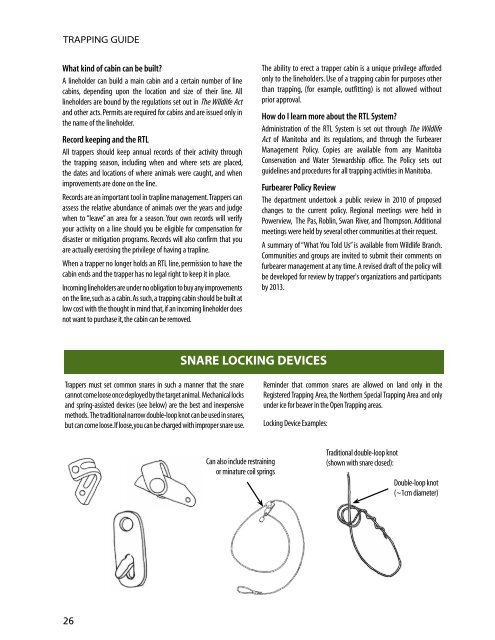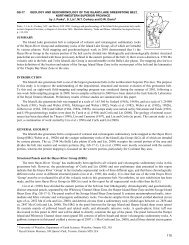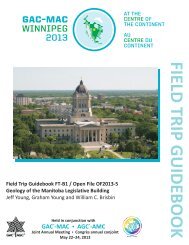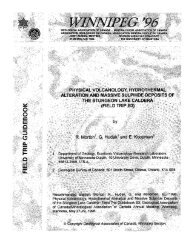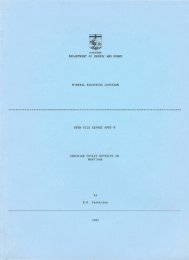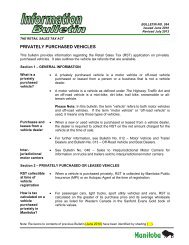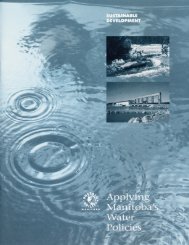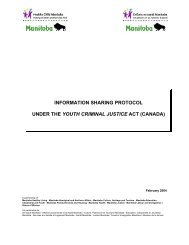Trapping Guide - Government of Manitoba
Trapping Guide - Government of Manitoba
Trapping Guide - Government of Manitoba
Create successful ePaper yourself
Turn your PDF publications into a flip-book with our unique Google optimized e-Paper software.
TRAPPING GUIDEWhat kind <strong>of</strong> cabin can be built?A lineholder can build a main cabin and a certain number <strong>of</strong> linecabins, depending upon the location and size <strong>of</strong> their line. Alllineholders are bound by the regulations set out in The Wildlife Actand other acts. Permits are required for cabins and are issued only inthe name <strong>of</strong> the lineholder.Record keeping and the RTLAll trappers should keep annual records <strong>of</strong> their activity throughthe trapping season, including when and where sets are placed,the dates and locations <strong>of</strong> where animals were caught, and whenimprovements are done on the line.Records are an important tool in trapline management. Trappers canassess the relative abundance <strong>of</strong> animals over the years and judgewhen to “leave” an area for a season. Your own records will verifyyour activity on a line should you be eligible for compensation fordisaster or mitigation programs. Records will also confirm that youare actually exercising the privilege <strong>of</strong> having a trapline.When a trapper no longer holds an RTL line, permission to have thecabin ends and the trapper has no legal right to keep it in place.Incoming lineholders are under no obligation to buy any improvementson the line, such as a cabin. As such, a trapping cabin should be built atlow cost with the thought in mind that, if an incoming lineholder doesnot want to purchase it, the cabin can be removed.The ability to erect a trapper cabin is a unique privilege affordedonly to the lineholders. Use <strong>of</strong> a trapping cabin for purposes otherthan trapping, (for example, outfitting) is not allowed withoutprior approval.How do I learn more about the RTL System?Administration <strong>of</strong> the RTL System is set out through The WildlifeAct <strong>of</strong> <strong>Manitoba</strong> and its regulations, and through the FurbearerManagement Policy. Copies are available from any <strong>Manitoba</strong>Conservation and Water Stewardship <strong>of</strong>fice. The Policy sets outguidelines and procedures for all trapping activities in <strong>Manitoba</strong>.Furbearer Policy ReviewThe department undertook a public review in 2010 <strong>of</strong> proposedchanges to the current policy. Regional meetings were held inPowerview, The Pas, Roblin, Swan River, and Thompson. Additionalmeetings were held by several other communities at their request.A summary <strong>of</strong> “What You Told Us” is available from Wildlife Branch.Communities and groups are invited to submit their comments onfurbearer management at any time. A revised draft <strong>of</strong> the policy willbe developed for review by trapper's organizations and participantsby 2013.SNARE LOCKING DEVICESTrappers must set common snares in such a manner that the snarecannot come loose once deployed by the target animal. Mechanical locksand spring-assisted devices (see below) are the best and inexpensivemethods. The traditional narrow double-loop knot can be used in snares,but can come loose. If loose, you can be charged with improper snare use.Reminder that common snares are allowed on land only in theRegistered <strong>Trapping</strong> Area, the Northern Special <strong>Trapping</strong> Area and onlyunder ice for beaver in the Open <strong>Trapping</strong> areas.Locking Device Examples:Can also include restrainingor minature coil springsTraditional double-loop knot(shown with snare closed):Double-loop knot(~1cm diameter)26


